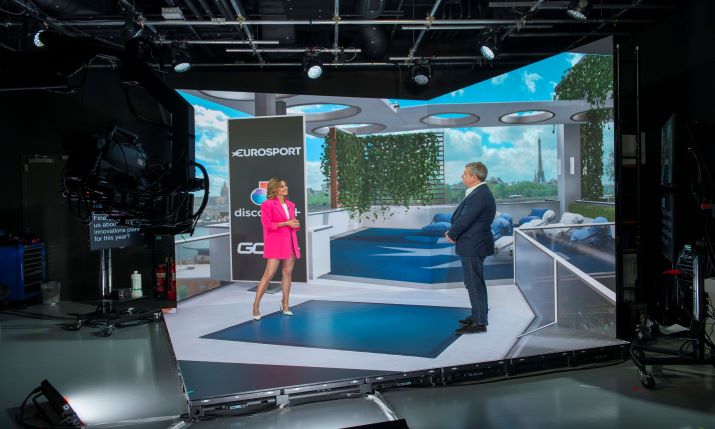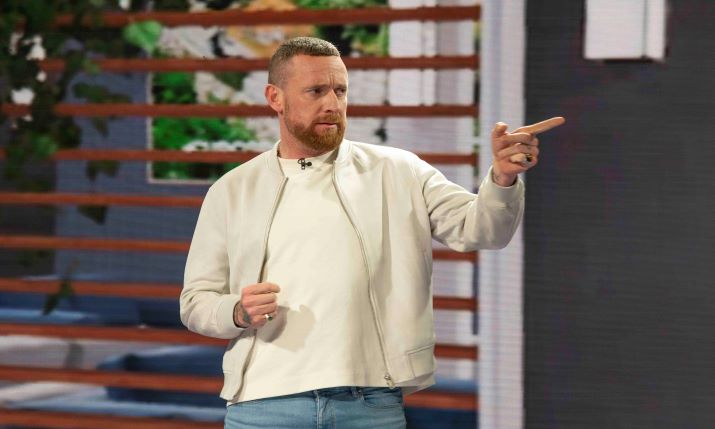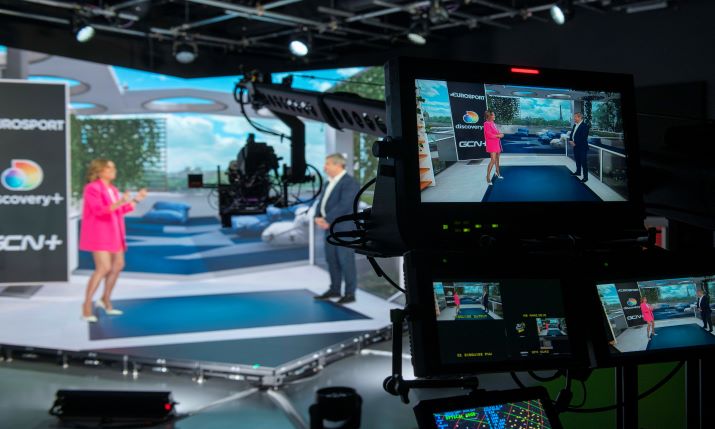Inside track: Discovery Sports’ Scott Young on the broadcaster’s plans for cycling world domination

Discovery’s SVP content and production in The Cube with presenter Orla Chennaoui
Discovery Sports senior vice president of content and production Scott Young recently spoke to SVG Europe about the broadcaster’s increasing plans in the world of cycling, which is one of its major sports verticals.
This year, Discovery Sports has added Tour de France Femmes and Paris-Roubaix Femmes rights in Asia-Pacific territories exclusively until at least 2025, France and Australia on a non-exclusive basis to 2025, Middle East and North Africa until 2023 and Latin American markets for the 2022 editions.
It is set to produce a hefty 600 individual broadcasts including over 1,200 live hours of cycling for coverage in 65 markets via Eurosport and discovery+, as well as 208 territories via GCN+, the cycling streaming channel.
Young discusses the plans for this year’s cycling extravaganzas and the new innovations that Discovery is set to bring to screens.
What’s your intention for this cycling world domination path you’re on? Where is it going and why are you so interested in cycling?
Cycling world domination? I love it. We don’t necessarily look at it that way in the sense that we are trying to dominate; we are mad sports fans and cycling has been such an important pillar of our sports line up. We have seven pillars of sport that deliver most of the content and cycling has a significant pillar for over three decades. Tour de France joined our screens in 1991, and cycling is just one of those sports that a Eurosport audience has always connected with.
“Women’s sport and gender equality is something that is not easily delivered and managed, but it’s an absolute focus. And I’ll always say, we’ve got a long way to go. We’re not sitting back saying we’ve actually managed to achieve this, but in working with our own production teams, our individual markets and sporting federations, we’re certainly making headway”
From that, obviously GCN became part of the family and the GCN platform is another extension of what Eurosport has been doing for many years for the true cycling fan that wants to continue the story when the race is over, and even the linear broadcast is over. So I think those two pieces together, along with Discovery+, which launched in the last 18 months and is becoming another strong streaming platform that bridges our entertainment product with our sporting product, now connect with cycling in a different way, and that grows our appetite for more cycling content.
I think your point about what looks like cycling world domination is a genuine appetite for all things road, track, on road, off road; it’s that ‘two wheels’ environment that we know we have a really connected audience in.
Our challenge, like all sports, at the end of each year as you lead into the new year, is how do you elevate the story? How do you bring the riders to life? How do we get a new audience that hasn’t properly ingratiated themselves with events like the Giro or Le Tour or the Vuelta? How do they become fascinated about cycling?
That’s our focus year on year. And I feel very comfortable that this year we’re on really good track to continue that trend of strong storytelling, innovative coverage and immersive coverage across those platforms.

Bradley Wiggins is going to become a one person remote production on a bike this year for Discovery
Do you have any plans for getting more rights on board this year?
Yes, we’re always looking for available rights that fit into the schedule and we’ve got to make sure we don’t become so greedy that we end up with a situation where we can’t actually schedule everything at once. But we have 300 events, which is over 600 days of cycling, which is roughly 1,200 hours of cycling on our platforms this year, so we’re pretty comfortable.
We’ve got what we think we need to make sure that if you’re a cycling fan, we are genuinely your destination. We are the home of cycling, but we’ve always got our head up looking around to see new events as opportunities arise, and the rights team are quick to pounce on anything that looks like it fits in.
It’s a constant and very organic process around particularly big pillars like cycling, like tennis; what’s around, what can we pick up and how does it fit within our schedule? But we are mindful that instead of just buying everything, we do need to make sure it actually fits with what we’ve got, otherwise we end up with effectively a gluttony of the same sport, and I don’t think that does anybody any favours.
On women’s cycling, and on women’s sport overall, how important is that to the Discovery brand?
Women’s sport is significantly important. Discovery Sport Together is a programme that we focus on regularly from a leadership perspective right down through to the production teams.
Women’s sport and gender equality is something that is not easily delivered and managed, but it’s an absolute focus. And I’ll always say, we’ve got a long way to go. We’re not sitting back saying we’ve actually managed to achieve this, but in working with our own production teams, our individual markets and sporting federations, we’re certainly making headway.
This year we saw equal [gender coverage] balance of 49% each side in the Australian Open broadcast, which we’re really pleased with. And it’s not just matches, but it’s focused around the replays, total number of hours and making sure that that’s actually a conscious part of the scheduling plan rather than just haphazardly noticing what happened at the end. And I think that’s a big difference.
Both Tokyo and Beijing were very close, equal balance. And the Olympics has again always been a focus on [gender equality coverage] as well. We’re now looking to cycling for that same balance and we’re working with many different territories on what are they doing around women’s cycling and how can we continue to elevate that.
Where it might not be exactly the same, we’re making sure that we are providing loads of input and support to promoters around how we can elevate it. We’ve been quite vocal to many organisers and event owners, the Tour De Femme for instance, about making sure that they are making sure that that lives on our screens with just as much promotion, popularity and presence as the Tour de France would be.

Scott Young and presenter Orla Chennaoui in The Cube ready for a year of cycling to begin
While it is obviously really important that women’s sport is represented equally on TV, what sort of growth market is this for you in terms of new fans, bringing new people into the sport?
Well, I’d say right now, we’re at the entry point. We know there’s a fan base for women’s sport, so I don’t think we need to analyse whether we think it’s going to work; it’s now a matter of [gender] balancing our schedules and then reviewing that once we’ve made sure we’ve got a decent balance.
The expansion is through what we believe to be the absolute right balance of programming. We’re not looking at it right now in an audience analytical sense. We’re not looking at it as, ‘if we do this can we grow our popularity or our fan base or our audience?’. This is absolutely the right thing to do and this is how sports should be portrayed across television and across our streaming platforms.
Once we believe we’ve invested the right time and production dollars and strategy across the different federations, then we can review how it’s gone and we fully expect it will bring in a stronger female audience. It will be an incremental audience, and we hope a younger audience as well by nature. But that will be a positive by-product of making sure we’ve got a good balance across our programming.
[Putting more women’s sport on our platforms is] definitely not a strategic play because I just think that’s completely the wrong angle in which to attach any of your programming. We look at it as a 24/7 sports broadcaster, living and breathing sport. We’ve got some challenges around diversity. I mean, we’ve got some challenges around the sort of sports that we have the rights to and their own balance in society. And it’s great to be able to sit down and have an open dialogue with the federations and the promoters of those sports and how we work together.
Moving onto The Cube at Tour de France Femme, you are bringing The Cube into play for the first time. What does bringing The Cube into this event mean?
We see The Cube as an amazing piece of innovative technology that elevates our storytelling. When you’re in The Cube, what the cube can do is phenomenal. But every time I’m around the team there at The Cube, or you even stand in The Cube and play around with it, i[I realise it is one of] the greatest storytelling tools I’ve seen developed in current television.
The ability for our talent and our experts to be in that immersive environment, to teleport athletes or riders into that environment, to Zoom them into locations where they are, to create a virtual augmented reality (AR) environment of looking at the terrain, the topography of a particular stage and where riders will have to attack and how that will actually play out in that day, explain the peloton to a new cycle audience that doesn’t understand that the person who’s probably going to win the stage that day is in the middle of that pack, and how does that unfold?
I mean, The Cube really comes to life when you want to tell that story. And then our studio facilities down in Bath have been fantastic. That’s the home of GCN and it’s a really important environment for us to make sure cycling is still focused down there. But when you look at something as grand an event as the Tour de France is, and the Tour de Femme, we’re going to be there for four months doing cycling. To have The Cube wrapped around those two events I think for us is a big step up. It’s an elevated status around our sports coverage, and that’s exactly what we want it to be.
On the new features and formats being unveiled across Discovery’s platforms throughout the year, what are those about?
Well, we’re always innovative, so Brad On A Bike for me is one of the best pieces. To actually have Sir Brad [Sir Bradley Wiggins, CBE] – as we like to call him – in the middle of a race explaining how the race is actually unfolding to the audience, has been brilliant. But currently the camera looks at Brad, so we’re looking at creative, innovative technology around his bike. You’ll start to see him on his bike in more and more races and we’ll start to see [him at] more Grand Tours, but also single day events where Brad is helping unpack the story.
[We are also looking at] having more cameras on [his bike] so effectively he can become a multi-camera remote production, because most people would love to be able to see what he can see. The way that the technology’s currently set up, we see him but from time to time he might spin the camera around to sort of go, “This is what I’m looking at,” but to have that POV look as to what he’s looking at as he’s explaining how the peloton’s going to unfold, that’s a pretty big piece for us.
The other piece we’re working on is with the UCI around things like Track Champions League; this was a big foray for us into taking track cycling and how do we innovate an event? How do we take a known and popular sport and take the races within that sport and tell that story completely differently? The events that we had last year, whilst some of the locations were impacted through COVID and where people could travel, it was great to see those roll out.
So, I think [we’re using] innovation through a couple of different ways; it’s using The Cube, it’s how do we innovate what our pundits like Brad can see when he is on a bike, and how do we work with the UCI on innovating total sports. The second season of Track Champions League will bring in more innovative storytelling.
Finally, on your localised shows, how important are those for growing audiences? What will they bring to your coverage that otherwise would be missed?
We run a pan production. We have 11 production centres that run off of two datacentres in London and Paris, which run two main production outfits. There are 11 production markets that localise production where they know there’s an audience that will gravitate [towards that content]. We have commentary in 19 languages and we distribute on any given day to 50 markets.
I mean these mathematics – or the mathematics gymnastics as I call them – are there as a base pan product. Where we look to local shows is where we’ll look to a cycling audience; we know that the cycling audience, once the stage or the race is finished, they will want to know what happens when the story continues. They want to see all the interviews, they want to hear from our pundits, they want to cross to our reporters at the finish line. So we localise a show that will be done out of The Cube, which is The Breakaway, which is not only the UK show, but it’s also the pan show. And then we have other programmes; we’ll either send The Breakaway to other markets that speak English and across the Netherlands and across the Nordics, English produced programmes are a very acceptable language, whereas in France, they want to make their own show; they have their own pundits and they want to tell their own story.
But the backbone of how we put all that together is still the pan production. The remote facility that drives all that is still one piece of technology with the cycling team driving that with effectively an octopus, with the tentacles going out to the different markets to the different territories that want to localise.
Where local riders particularly do well, like in the Netherlands, like in Denmark, in Spain, in France and the UK, those particular local shows are following their stories and their riders, but they’re working off a common backbone that Discovery Sports delivers to make all these shows possible.
In addition to offering fans live coverage of the widest range of races on the UCI WorldTour and Women’s WorldTour, Discovery also shows every classic road race, it shows every track, cyclocross, mountain bike, BMX and urban cycling World and European Championship events.
